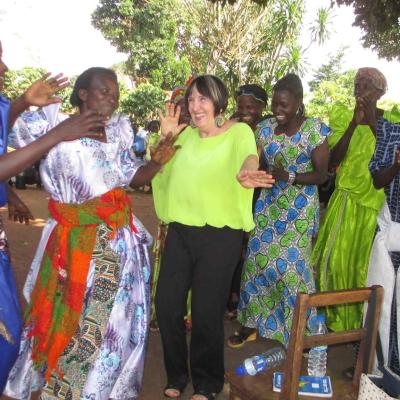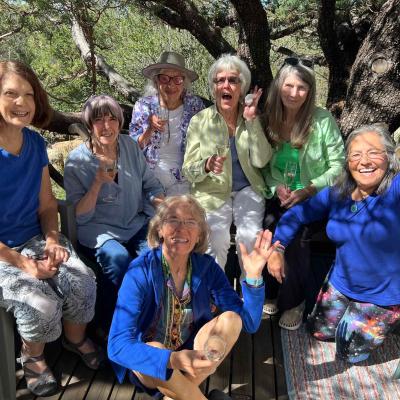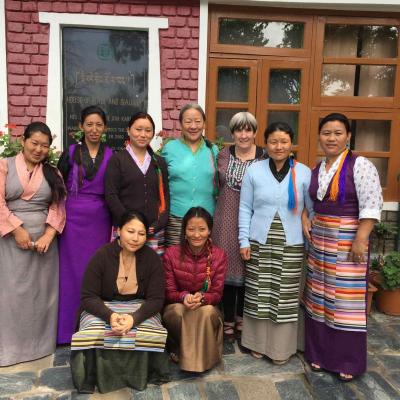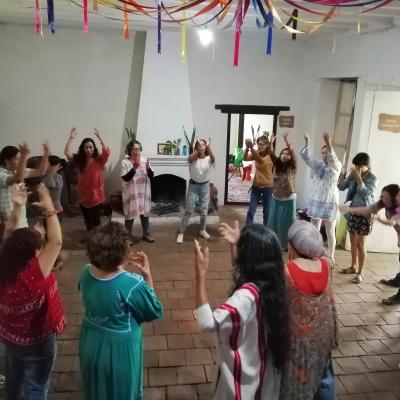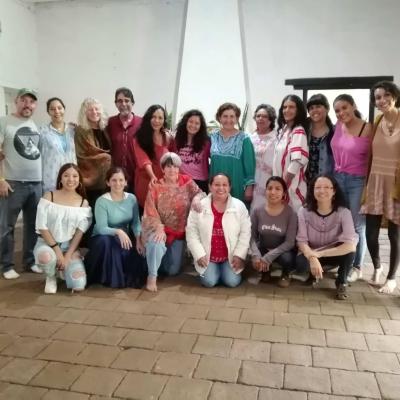In S. Mijares, A. Rafea and N. Angha (Eds.) (2013). A Force Such As the World Has Never Known: Women Creating Change (Toronto, Canada, Inanna Publications and Education).
Chapter Twenty-eight
We Honor Her Beauty; Now It’s Time to Embody Her Power
Sharon G. Mijares
United States
The United States has been a forerunner of change for the last three hundred years. Although some of this change has been for the good, at the same time, due to its ethnocentricity and goal of global superiority, it has also created numerous problems around the world. On the positive side, the United States has been a leader in times of environmental disasters; for example, it contributed more aid to Indonesia and nearby nations following the 2005 Tsunami and to Haiti following the devastating earthquake in 2010 than any other nation in the world. Yet at the same time, the U.S. has perpetuated a paradigm of political and economic supremacy ignoring, and/or often stifling, the unique qualities of cultures different than our own. Through the spread of global trade, travel, the Internet, media, and, in particular, Hollywood and mtv-style videos, the United States has impacted the world more than any other nation. But there is also a big loss in this paradigm, as the uniqueness of each culture—its specific ways of praying, eating, dressing, expression of dance and music, along with its philosophical understanding and ways of communicating—may soon be nothing more than a historical memory. Despite the history of U.S. exceptionalism, an increasing number of its women are reaching out in new ways, creating friendships rather than enemies—joining with other women around the globe, via the Internet and conferences, with the shared intention of healing our human family. This chapter will discuss some of the ways that American women are connecting with women from both within the U.S. and also with other nations by honoring diversity, rather than repeating the ethnocentric behaviors of the U.S. past. We want to honor and to learn from the unique understanding and experience of women from around the world. We also want to respect multicultural ideas of feminism as opposed to following old theories developed from studies of white, educated, middle-class women and that may represent limited cultural perspectives. The ongoing challenge will be that of relinquishing any introjected patterns and attitudes of superiority initiated by this tendency of viewing ourselves as models for others. For example, the U.S. is not always the first nation to create positive changes for women. For this reason, we, the editors of this book, have gathered women from various cultures to share their stories. The goal of progressive women’s movements should not be hierarchical—nor should it be built upon corporate structures bringing women together primarily for the purpose of commercial gain.
Other authors in this book have noted the numerous obstacles they face in their unique contributions to the effort for gender equality. In particular, this author believes that the biggest obstacle in U.S. women’s endeavors is the danger of creating structures built upon a for-profit model—as this is the paradigm of our patriarchal past. Instead, we need to gather others in the name of shared, feminine power. Our work is that of balancing feminine power and beauty—for the benefit of all. It is an egalitarian model open to new ways of living and being, because the current models—based on consumerism and hierarchical power—are failing. It is so easy for groups to fall into this pattern, as it has been the model we have followed for several thousand years. True feminism emanates the beauty of caring and the power to create change.
UN Resolution 1325
This resolution, adopted on October 31, 2000, marked another step in the progress of gender equality, as the resolution affirms the importance of women
in the prevention and resolution of conflicts, peace negotiations, peace-building, peacekeeping, humanitarian response and in post-conflict reconstruction and stresses the importance of their equal participation and full involvement in all efforts for the maintenance and promotion of peace and security (Womenwatch).
Given the long-time history of global patriarchal (namely male) dominance, it remains a slow, ongoing and arduous task to actualize this intention. But, as the contributors to this volume demonstrate, it is up to women to join in the effort to create a more positive world for future generations.
My own contributions have primarily come through writing and workshops. In 2003, I invited Dr. Aliaa Rafea, an Egyptian Muslim; Rachel Falik, an Israeli Jew; and, later in 2006, Jenny Eda Shipper, a New Age yoga teacher, massage therapist and poet, to join with me in pointing out the evils of a patriarchal social structure along with the importance of women’s role in global transformation through our book, The Root of All Evil: An Exposition of Prejudice, Fundamentalism and Gender Imbalance. We began this not long after the events of 9/11 and the attacks on Afghanistan and Iraq. The idea of Christian, Jewish, Islamic and New Age co-authors was an effort at unifying women of diverse backgrounds in the shared goal of peace. Our research affirmed the balance and healing that women’s presence can bring in political, economic, religious and other social arenas in life—along with the need for gender balance. We also demonstrated a method for working together, despite differing backgrounds and beliefs.
A few years later, when doing some research for an article I was writing for the journal Adaptive Options, I learned that Eleanor Roosevelt had noted the importance of gender balance as a way of resolving many of the world’s problems in her own book, This Troubled World. She emphasized the role of a love that extended beyond one’s personal relationships to include the entirety of the human family. She noted that this would be our saving grace AND that women were capable of this because of their inherent maternal qualities.
Nurturing qualities do not have to be limited to the birthing and caretaking of one’s own children—but rather extend to caring for the entire human family. But women have to “wake up” and recognize the potential depth within this inherent relational quality. Far too many young women are content to play the role of sexual objects (as evidenced through various media). The U.S. media and its wide viewership tends to give more attention to the behavior of a young movie star than to educate about atrocities happening to women and children around the world.
Many women prefer to remain oblivious, and they do this through a variety of means: hiding behind their husbands. for example (how many of us have heard others say that a leader’s wife is running things behind the scenes) and/or blindly accepting religious, economic and social limitations. Thus, women’s overall presence and participation is limited and gender balance denied. Many women are still content to be “second-best”—abdicating their capacity for research, thought and action, and therefore the power of decision-making to men. If we look at the current state of the world, where power for its own sake and financial interests rule, it becomes obvious that something more is needed.
In a patriarchal culture someone always has to be superior to another. If the woman is placed on the bottom rung, due to the assumptions of those “above” her, she is more apt to belittle and demean others in an attempt to rise higher on the ladder (however misguided this may be). But if her heart is open to a deeper level of caring, she has much to offer as long as she resists the temptation to take power for its own sake, for example, making the women’s movement one of corporate intent as opposed to creating sustainable relationships and ways of living.
The First Wave of Feminism and Work for Gender Balance
On August 26, 1920, the 19th Amendment to the U.S. Constitution was ratified and women were given the right to vote. This amendment is also known as the Susan B. Anthony Amendment due to her amazing courage, willingness and work to assure that women would have this right. But she was just one woman among many, and this victory was the result of almost a century of work by its numerous advocates. The women’s suffrage movement was influenced in its beginnings by Francis Wright (1795-1852) and Ernestine Rose (1810-1892). Wright had emigrated from Scotland to the U.S.in 1818, bringing with her beliefs in the value of universal equality and feminism; Rose emigrated from Poland in 1836. Both worked diligently for women’s suffrage. Later, women such as Lucretia Mott, Margaret Fuller, the ex-slave Sojourner Truth, Elizabeth Cady Stanton, Lucy Stone, Susan B. Anthony and numerous other women were willing to be jailed, beaten, and suffer public humiliation for the cause of gender equality, and, in particular, the right for women to make decisions in governance of this country—to vote. Not all women supported equal rights. Many believed this arena to be the realm of men, and men alone, adhering to patriarchal ideology. This same struggle for women’s suffrage was not just taking place in the U.S., nor was the United States the first to obtain it: in 1893 New Zealand became the first country in the world to grant women the equal right to vote.
Women in the United States have not been the first to obtain equal rights in a variety of areas. Although U.S. women are often quick to either criticize or to genuinely feel sympathy for women’s suppression in other countries, they often fail to realize that it has been for a relatively short time in American history that women have had the right to own property or to divorce. Many women are unaware that, until the mid-1800s, U.S. women did not have the right to own property separate from their husbands. Compton’s Interactive Encyclopedia (1995), in an excerpt re-posted on the Women’s International Center website notes:
During the early history of the United States, a man virtually owned his wife and children as he did his material possessions. If a poor man chose to send his children to the poorhouse, the mother was legally defenseless to object. Some communities, however, modified the common law to allow women to act as lawyers in the courts, to sue for property, and to own property in their own names if their husbands agreed. Gradually, the states granted women limited property rights. By 1900 every state had granted married women considerable control over their property.
In our research, we also learned that women were not allowed the right to execute a will until 1809. In 1839, “Mississippi passed a law granting women limited property rights, the beginning of a series of successes—part of a long arduous struggle” (Mijares, Rafea, Falik, and Schipper, 2009, p. 158).
The feminist movement revived itself in the 1960s. Women began to speak out against sexual hypocrisy, such as the “double standard” for males and females when it came to sexual permissiveness and the like. Many symbolically burned their bras in university campus demonstrations (during this era, gender rights issues were also present in China, France, and Germany as well as other countries). The rise in U.S. feminism was also in alignment with the Civil Rights movement, as both African Americans and women demanded equality. Many women and men spoke out against the Vietnam War and the act of warring itself. Women began to expand professional opportunities, beyond that of caretaking professions. This included managerial positions. Yet, despite decades of awareness and united effort, males are still at the pinnacle of administrative positions, often earning higher wages for the same work as women.
There have been many stigmas propagated in response to feminism. Many people feared the relationship between feminists’ ideals of equality and socialism.1 The term “feminist” also became synonymous to some with “angry” and “aggressive” women. These negative associations were spread as a way of demeaning feminists and feminism. These insinuations still have a certain amount of influence by disregarding a women’s right to have a voice, to speak out against injustice or to simply expect equality. If she is associated with the image of an “angry feminist” than her words (their intention and meaning) are negative. If these feminists had not spoken out and taken positions against patriarchal power, positive changes for women would not have occurred.
The Second Wave of Feminism: The Awakening of the Feminine
In 1984, I was introduced to a new book, Goddesses in Everywoman, by Jungian psychiatrist Jean Shinoda Bolen. Other friends were reading this book and we often had discussions as to which of these archetypal Greek Goddesses might have the largest impact in our own lives. Were we led by Hera, the devoted wife archetype, or Demeter, the mother with her associated maternal instincts? Or were we impelled by the archetypal influences of Artemis or Athena—virgin Goddesses representing wholeness in oneself? Prior to this time there was little, if any, discussion of Goddesses—let alone thoughts about their actual influences in our lives.
Women began reading books such as Merlin Stone’s When God Was a Woman (1976). This book documented stories of Goddesses from numerous ancient cultures—stories very different than the Biblical rendition of Eve, destined to be the Judeo-Christian scapegoat for all sin, born from Adam’s rib and then causing all woe to befall humankind. No one had ever told us that there were other versions of this tale such as the one of Lilith, Adam’s first wife. We did not know of Sophia, the Greek name for the ancient Hebrew Goddess of holy wisdom, Hokhmah.2 Women were waking up to previously unknown revelations.
Patriarchal religions had denounced Goddess-worshipping cultures, or ignored them completely because they were paganistic (honoring a variety of deities instead of an ultimate source of creation—proclaimed to be male). Many women learned that in earlier times the divine was believed to be feminine, because of the fact that women birthed life. In many earlier cultures, such as those of Rome and Greece, Goddesses were equal to Gods. Goddesses reigned in Celtic and ancient European eras. In Shamanic cultures, the Shaman (Medicine person, healer) can be either male or female—but generally this person has gone through an inner process that initiates gender balance as part of awakening to the Shamanic gifts. As we re-learned history, ideas of gender were changing. Women were re-discovering themselves and a very different identity was being revealed.
Marija Gimbutas, an archeologist revealing ancient findings from the Neolithic era showing the existence of women-centered (matristic) civilizations built around a feminine deity (or deities), also had a big influence on this awakening. Archeologists were finding sacred replicas (statues and so forth) representing the feminine as divine. These stories had simply not been told, yet we would soon learn they were abundant in every culture—negated by patriarchal religions, damned as part of our pagan past. Women were beginning to have a very different image of what it meant to be a woman. The images of powerful birthing Goddesses acknowledging the feminine who brought life into the world propelled a new strength into feminism and feminist action. Added to the concerns for equality and human rights—feminism began to recognize that it was holy. Feminism was also sacred! The emphasis was on the beauty of women, the earth and the capacity for birthing new life.
Women’s groups formed, simply to share and discuss our feminine identity, and to acknowledge our feelings as women and as mothers. They also affirmed our sexuality. These stories about Goddess cultures were shared (Mijares, 2003), and women began to have a stronger sense of a healthy feminine identity—a new sense of beauty.
In my own groups, I often focused on women learning to trust and to share their vulnerability with one another. This was a major issue for many women had internalized many long-held influences from biased religious teachings. We were psychically controlled by patriarchal images and teachings instilling mistrust in one’s feminine self while creating barriers between ourselves and other women. Also, as I noted in the Introduction to this book, if women are placed “below” the male, one way to feel superior is to demean another woman. Women’s gatherings sought to change this irrational behavior and create an environment of trust and support.
The United States has always had its share of women’s groups associated with religious communities and/or political parties. There are certainly numerous women’s associations focused on helping the poor, or deprived children and many other very important causes. But these groups have not deliberately focused on awakening the feminine within and empowering women to connect with one another. This second wave of feminism differed because of this shift, but the next wave of feminism would bring connectedness to a whole new level.
The Third Wave of Feminism: Promoting Unity for Global Change
In 1993, the group Women of Vision and Action (wova) formed in response to a Middle Eastern woman sharing her story of the death of family members during a civil war. Her tearful request was to “call the women together” and begin a much-needed change. Rana Vernon listened and within two years a conference, Women of Vision: Leadership for a New World, was held in Washington, D.C. (More information on wova can be found on their website, www.wova-archive.org). I remember attending wova groups in San Diego in those early years. In fact, I presented a talk on women and healing at one of their conferences as did another author in this volume, Dr. Deva Beck.
Eventually, wova transformed itself into the Gather the Women (gtw) movement in 2001. Since then it has continued to grow—with the intention of gathering women from around the planet, although its primary membership is U.S. women. GTW sees and uses the internet as a means of connecting and global outreach. The primary focus is on feminine connectedness—building relationships. gtw differs from women’s ngos that focus on a specific cause, such as preventing violence against women, empowering women in war-stricken areas, environmental concerns, trafficking, or other significant needs, as gtw primarily desires to build on the strength of the many. The intention is one of promoting connectedness and support for its growing membership.
Likewise, another group, Jean Shinoda Bolen’s Millionth Circle movement, based upon her book of the same title, emphasizes “the power of the many” to create change and social connectedness. Bolen has continued to have a large influence on women since her book, Goddesses in Every Woman, was released in 1984. As a psychiatrist, author and leader, she has been one of the larger influences in this female-affirming movement.
These social connections, along with the internet, represent a powerful tool for both informing and connecting. The third wave of feminism has utilized this power to spread its message. Many women are providing various means to empower the movement. Another example is World Pulse, located in Portland, Oregon. It provides a free on-line magazine (available at worldpulse.com) that introduces its reader to various women throughout the world who are making a difference in their communities. The magazine’s intention is to “broadcast and unite women's voices from around the world into a powerful force for change.”
More recently, the Internet has been used to promote a wider movement in this area. It began with a large e-mail campaign noting an opportunity to gather with well-known New Age authors and leaders via a “live” call-in web-cast. These speakers discussed the vision of women, men and children joining to create much-needed change. The discussions were recorded so that the archives were available to all and could be accessed at any time. Notices of each live call-in were sent out in vast emails and social networks were encouraged to pass them on. The primary draw (besides an opportunity to be on the phone line with popular teachers) was engaging in a large movement to empower women motivated to create change.
Social connectedness via the Internet appeared to be activating women’s capacity to help transform the numerous global problems facing this humanity—but with one little glitch. The emailed notices began to include the announcement of ongoing, in fact, several weeks of training in the area of feminine empowerment—for a fee.
A pattern had emerged. First, thousands of emails were sent out to announce the opportunity—that of electronic networks providing a means of connectedness with other women. Popular leaders and/or influential women’s groups were used to draw in likely participants. The initial connection, typically a free one to two hour call-in each week or so develops a good data base as word of these tele-courses spread. This list was then used for commercial reasons as “for-profit” workshops were offered in the guise of spirituality and transformation, leadership and self-empowerment.
The marketing appears to have been a success, but does our nation, and our world, need more of the same thing—where the bottom line is the dollar? It appears as though U.S. women might simply be following the capitalist ideal—the model propagated by the male majority. Although this is a creative way to spread good messages and to earn money, it is not simply and purely for the benefit of humankind.
This is a capitalist society—often referred to as corporate America. But this ideology comes at a cost considering that our humanity and environment are seriously threatened and we can no longer afford the continued patterns of our patriarchal past. This structure does not represent feminine power. Our efforts need to arise from a deeper feminine caring, something deep within each woman. We need to create new ways, especially in these times of economic unrest.
Change-bringers need to first free themselves from the corporate influence that makes everything—including this precious endeavor of gender balance for the good of humanity—yet another commodity or another hierarchical power structure. I have seen far too many women striving to both initiate and lead large global gatherings to unite women while following masculine models with strong leadership “at the top.”
The belief attributed to Matthew Arnold, that “If ever women gathered together simply and purely for the benefit of [hu]mankind that it would be a force such as the world had never known,” goes far beyond the “profit” motive. In fact, my concerns about these issues initiated the idea for this book. I awakened one morning with the idea to bring numerous women together to share their stories and experience—contributing to an egalitarian dialogue--without a bunch of hoopla or unnecessary fuss. The goal was to simply provide examples of what women around the world were doing—each in her own way, and according to the needs to her culture. No corporate structure, funding or the like would be necessary—simply the reaching out to invite women in various nations around the world to share their stories, their obstacles and their successes. In fact, this feminist model of “power with” has influenced all of my prior books. I knew I could do the research and write the chapters, but I would rather those with expertise in specific areas share their stories. This is especially powerful when bringing people together from differing cultural, racial and religious backgrounds. It represents yet another egalitarian model, which has been the goal of every wave of feminism.
An Emphasis on Power and Beauty
As discussed, the feminists of the 1970s were portrayed as a group of “angry women,” but there were good reasons to be angry. Their important efforts often went unseen as the “angry feminist” stereotype gained more power than what the women were attempting to point out and change.
Far too many people fall for the projected images put out by those who would maintain the status quo, who wish to keep things as they are. And far too many women want to be nice to ensure approval, rather than to express—or even be conscious of—what they really believe. This is not an authentic representation of feminine beauty nor does it indicate the presence of feminine power.
The great ethnologist, Konrad Lorenz, noted that aggression was an innate expression meant to protect and preserve life. It is found in some form or another in all species. It is generally accepted as a male trait. The mother instinct alone should make women angry enough to join in the cause to preserve future generations. We don’t have to rant, rave, growl or swear—or go to war against another nation—but this “caring” energy can be harnessed to speak for truth, and to gather for the sake of all life in order to create change. In this way, the anger and motivating aggression transforms and becomes a great force—one that is motivated by love and wisdom. This earth-moving fire within us will be ignited as all nature moves toward right balance. Remember Mother Earth has fire at the center of her core. Nature demonstrates a variety of forces—and this model is available to empower us as we are her offspring—the children of heaven and earth, of spirit and form.
Yes, the women of the United States need to free themselves from the corporate influence that makes everything a commodity. And, we also need to discard the illusion that the United States is superior and that it is the example for all to follow. Every culture, with its unique environment, heritage, religion and so forth has something to contribute to this human family. We must each free ourselves inwardly and outwardly from the shackles of patriarchy and its bedfellow, corporate power, wherein something or someone always has to be better than another.
Women must also individually and collectively heal our relationships with one another. Mothers, daughters and sisters must unite. Early and latter developments in feminism need to learn from one another. If each generation disregards the efforts and personhood of others, we have a disconnect—a split that weakens our efforts to improve conditions wherein equality and goodness will be available to all human beings and all life. When we individually take responsibility for our motivations and behaviors, both with ourselves and with others, discernment and self-knowledge result. Authentic self-knowledge is an empowering influence that spreads—initiating healing and impacting upon relationships in positive ways.
In the Introduction I shared an experience that had occurred in response to an assignment in a Creative Writing course. I chose to allow the words of the Earth Mother to flow through me—spontaneously—without thought or reflection. I will end this chapter by repeating the message that preceded the synchronistic earthquake.
You walk upon my paths, and acknowledge my beauty.
But you do not know my power—
the power to push forth mountain peaks and open valleys for oceans to fill.
We need to find this right balance of power and beauty and let it be what leads us, creating a new paradigm for the good of all. If we give her our attention, Nature will guide us.
[
“About World Pulse.” http://worldpulse.com/about/worldpulse. Web.
Bolen, Jean Shinoda. Goddesses in Everywoman. New York, NY: HarperCollins, 1984. Print.
Bolen, Jean Shinoda. -------. The Millionth Circle: How to cChange oOurselves and the wWorld. Berkeley, CA: Conari Press. 1999. Print.
“Christian feminism.” Wikipedia.
Evangelical and Ecumenical Women’s Caucus (EEWC) Conference 2004. Christian Feminism
“Landmark resolution on Women, Peace and Security.” Office of the Special Advisor on Gender Issues and Advancement of Women.
Lorenz, Konrad. On Aggression. New York, NY: Bantam Books, 1967. Print.
Mijares, Sharon G. “Adapting to Change is a Gender Issue.” Adaptive Options 5.1 (Spring 2010). 13-28. Print.
Mijares, Sharon G. (2003) “Tales of the Goddess: Healing Metaphors for Women.” In Modern Psychology and Ancient Wisdom: Psychological Healing Practices from the Worlds Religious Traditions. Edited by S. Mijares. New York, NY: Routledge Mental Health, 2003. 71-96. Print. REVISED 2016
Mijares, Sharon G., Aliaa Rafea, Rachel Falik and Jenny Eda Schipper. The Root of All Evil: An Exposition of pPrejudice, fFundamentalism and gGender iImbalance. Exeter, UK: Imprint Academic, 2007. Print.
Roosevelt, Eleanor. This Troubled World. New York, NY: H.S. Kinsey & Company, 1938
Stone, Merlin. When God Was a Woman. New York, NY: Harcourt, Brace and Co., 1976. Print.
Weedon, Chis. “Key Issues in Postcolonial Feminism: A Western Perspective.” Presentation at Gender Forum: Genderrealizations. (2002).
Women’s International Centre (WIC). —“Women’s History in America.” Web. 11 Jul. 2013.
“Women of Vision and Action.”

